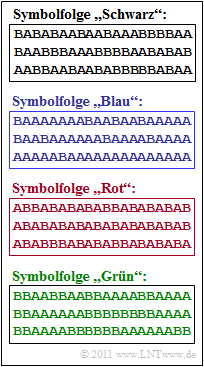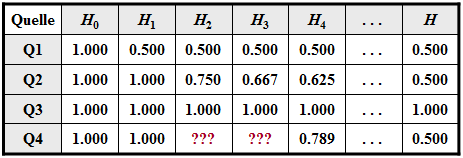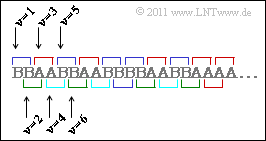Difference between revisions of "Aufgaben:Exercise 1.3: Entropy Approximations"
m (Text replacement - "Category:Aufgaben zu Informationstheorie" to "Category:Information Theory: Exercises") |
|||
| Line 3: | Line 3: | ||
}} | }} | ||
| − | [[File:Inf_A_1_3_vers2.png|right|frame| | + | [[File:Inf_A_1_3_vers2.png|right|frame|Different binary sequences]] |
| − | + | The diagram shows four symbol sequences $\langle q_\nu \rangle $ , each with length $N = 60$. The source symbols are $\rm A$ and $\rm B$ respectively. | |
| − | * | + | *It follows directly that $H_0 = 1 \; \rm bit/symbol$ applies to the decision content of all sources considered. |
| − | * | + | *However, the symbols $\rm A$ and $\rm B$ do not occur with equal probability, but with the probabilities $p_{\rm A}$ and $p_{\rm B}$. |
| − | + | In addition to $H_0$ , the table below shows the entropy approximations | |
| − | * $H_1$, | + | * $H_1$, based on $p_{\rm A}$ und $p_{\rm B}$ (column 2), |
| − | * $H_2$, | + | * $H_2$, based on two-tuples (column 3), |
| − | * $H_3$, | + | * $H_3$, based on three-tuples (column 4), |
| − | * $H_4$, | + | * $H_4$, based on four-tuples (column 5), |
| − | * | + | * the actual entropy $H$, which is obtained from $H_k$ by the boundary transition for $k \to \infty$ (last column). |
Revision as of 19:26, 8 May 2021
The diagram shows four symbol sequences $\langle q_\nu \rangle $ , each with length $N = 60$. The source symbols are $\rm A$ and $\rm B$ respectively.
- It follows directly that $H_0 = 1 \; \rm bit/symbol$ applies to the decision content of all sources considered.
- However, the symbols $\rm A$ and $\rm B$ do not occur with equal probability, but with the probabilities $p_{\rm A}$ and $p_{\rm B}$.
In addition to $H_0$ , the table below shows the entropy approximations
- $H_1$, based on $p_{\rm A}$ und $p_{\rm B}$ (column 2),
- $H_2$, based on two-tuples (column 3),
- $H_3$, based on three-tuples (column 4),
- $H_4$, based on four-tuples (column 5),
- the actual entropy $H$, which is obtained from $H_k$ by the boundary transition for $k \to \infty$ (last column).
Zwischen diesen Entropien bestehen folgende Größenrelationen: $H \le$ ... $\le H_3 \le H_2 \le H_1 \le H_0 \hspace{0.05cm}.$
- Nicht bekannt ist die Zuordnung zwischen den Quellen $\rm Q1$, $\rm Q2$, $\rm Q3$, $\rm Q4$ und den in der Grafik gezeigten gezeigten Symbolfolgen (Schwarz, Blau, Rot, Grün).
- Es ist lediglich bekannt, dass die Quelle $\rm Q4$ einen Wiederholungscode beinhaltet. Aufgrund der Tatsache, dass bei der entsprechenden Symbolfolge jedes zweite Symbol keinerlei Information lierfert, ist $H_0 = 0.5 \; \rm bit/Symbol$.
- Zudem sind die Entropienäherungen $H_1 = 1 \; \rm bit/Symbol$ (gleichwahrscheinliche Symbole) und $H_4 \approx 0.789 \; \rm bit/Symbol$ gegeben.
Zu bestimmen sind für diese Nachrichtenquelle $\rm Q4$ schließlich noch die Entropienäherungen $H_2$ und $H_3$.
Hinweise:
- Die Aufgabe gehört zum Kapitel Nachrichtenquellen mit Gedächtnis.
- Für die $k$–te Entropienäherung gilt bei Binärquellen $(M = 2)$ mit der Verbundwahrscheinlichkeit $ p_i^{(k)}$ eines $k$–Tupels:
- $$H_k = \frac{1}{k} \cdot \sum_{i=1}^{2^k} p_i^{(k)} \cdot {\rm log}_2\hspace{0.1cm}\frac {1}{p_i^{(k)}} \hspace{0.5cm}({\rm Einheit\hspace{-0.1cm}: \hspace{0.1cm}bit/Symbol}) \hspace{0.05cm}.$$
Fragebogen
Musterlösung
- da die Symbole gleichwahrscheinlich sind ⇒ $H_1 = H_0$ und
- keine statistischen Bindungen zwischen den Symbolen bestehen ⇒ $H=$ ... $= H_2 = H_1$.
(2) Man erkennt bei der blauen Binärfolge, dass $\rm A$ sehr viel häufiger auftritt als $\rm B$, so dass $H_1 < H_0$ gelten muss.
- Entsprechend der Tabelle erfüllt nur die Quelle $\underline{\rm Q1}$ diese Bedingung.
- Aus $H_1 = 0.5 \; \rm bit/Symbol$ kann man die Symbolwahrscheinlichkeiten $p_{\rm A} = 0.89$ und $p_{\rm B} = 0.11$ ermitteln.
(3) Durch Ausschlussverfahren kommt man für die rote Binärfolge zum Ergebnis $\underline{\rm Q2}$:
- Die Quelle $\rm Q1$ gehört nämlich zur blauen Folge, $\rm Q3$ zur schwarzen und $\rm Q4$ zum Wiederholungscode und damit offensichtlich zur grünen Symbolfolge.
- Die rote Symbolfolge weist folgende Eigenschaften auf:
- Wegen $H_1 = H_0$ sind die Symbole gleichwahrscheinlich: $p_{\rm A} = p_{\rm B} = 0.5$.
- Wegen $H < H_1$ bestehen statistische Bindungen innerhalb der Folge.
- Diese erkennt man daran, dass es zwischen $\rm A$ und $\rm B$ mehr Übergänge als bei statistischer Unabhängigkeit gibt.
(4) Bei der grünen Symbolfolge $($Quelle $\rm Q4)$ sind die Symbole $\rm A$ und $\rm B$ gleichwahrscheinlich:
- $$p_{\rm A} = p_{\rm B} = 0.5 \hspace{0.3cm}\Rightarrow\hspace{0.3cm}H_1 = 1\,{\rm bit/Symbol} \hspace{0.05cm}.$$
Zur $H_2$-Ermittlung betrachtet man Zweiertupel. Die Verbundwahrscheinlichkeiten $p_{\rm AA}$, $p_{\rm AB}$, $p_{\rm BA}$ und $p_{\rm BB}$ können daraus berechnet werden. Aus der Skizze erkennt man:
- Die Kombinationen $\rm AB$ und $\rm BA$ sind nur dann möglich, wenn ein Tupel bei geradzahligem $\nu$ beginnt. Für die Verbundwahrscheinlichkeiten $p_{\rm AB}$ und $p_{\rm BA}$ gilt dann:
- $$p_{\rm AB} \hspace{0.1cm} = \hspace{0.1cm} {\rm Pr}(\nu {\rm \hspace{0.15cm}ist\hspace{0.15cm}gerade}) \cdot {\rm Pr}( q_{\nu} = \mathbf{A}) \cdot {\rm Pr}(q_{\nu+1} = \mathbf{B}\hspace{0.05cm} | q_{\nu} = \mathbf{A}) = {1}/{2} \cdot {1}/{2} \cdot {1}/{2} = {1}/{8} = p_{\rm BA} \hspace{0.05cm}.$$
- Dagegen gelten für die beiden weiteren Kombinationen $\rm AA$ und $\rm BB$:
- $$p_{\rm AA} ={\rm Pr}(\nu = 1) \cdot {\rm Pr}( q_1 = \mathbf{A}) \cdot {\rm Pr}(q_{2} = \mathbf{A}\hspace{0.05cm} | q_{1} = \mathbf{A}) + {\rm Pr}(\nu=2) \cdot {\rm Pr}( q_{2} = \mathbf{A}) \cdot {\rm Pr}(q_{3} = \mathbf{A}\hspace{0.05cm} | q_{2} = \mathbf{A}) \hspace{0.05cm}.$$
- $$\Rightarrow \hspace{0.3cm}p_{\rm AA} = \frac{1}{2} \cdot \frac{1}{2} \cdot 1+ \frac{1}{2} \cdot \frac{1}{2} \cdot \frac{1}{2} = \frac{3}{8} = p_{\rm BB} \hspace{0.05cm}.$$
- Hierbei steht $\nu = 1$ für alle ungeradzahligen Indizes und $\nu = 2$ für alle geradzahligen Indizes.
- Damit ergibt sich für die Entropienäherung:
- $$H_2 = \frac{1}{2} \cdot \left [ 2 \cdot \frac{3}{8} \cdot {\rm log}_2\hspace{0.1cm}\frac {8}{3} + 2 \cdot \frac{1}{8} \cdot {\rm log}_2\hspace{0.1cm}(8)\right ] = \frac{3}{8} \cdot {\rm log}_2\hspace{0.1cm}(8) - \frac{3}{8} \cdot {\rm log}_2\hspace{0.1cm}(3) + \frac{1}{8} \cdot {\rm log}_2\hspace{0.1cm}(8) \hspace{0.15cm} \underline {= 0.906 \,{\rm bit/Symbol}} \hspace{0.05cm}.$$
(5) Nach ähnlichem Vorgehen kommt man bei Dreiertupeln zu den Verbundwahrscheinlichkeiten
- $$p_{\rm AAA} \hspace{0.1cm} = \hspace{0.1cm} p_{\rm BBB} = 1/4 \hspace{0.05cm},\hspace{0.2cm} p_{\rm ABA} = p_{\rm BAB} = 0 \hspace{0.05cm},\hspace{0.2cm} p_{\rm AAB} \hspace{0.1cm} = \hspace{0.1cm} p_{\rm ABB} = p_{\rm BBA} = p_{\rm BAA} = 1/8$$
und daraus zur Entropienäherung
- $$H_3 = \frac{1}{3} \cdot \left [ 2 \cdot \frac{1}{4} \cdot {\rm log}_2\hspace{0.1cm}(4) + 4 \cdot \frac{1}{8} \cdot {\rm log}_2\hspace{0.1cm}(8)\right ] = \frac{2.5}{3} \hspace{0.15cm} \underline {= 0.833 \,{\rm bit/Symbol}} \hspace{0.05cm}.$$
Zur Berechnung von $H_4$ ergeben sich folgende $16$ Wahrscheinlichkeiten:
- $$p_{\rm AAAA} \hspace{0.1cm} = \hspace{0.1cm} p_{\rm BBBB} = 3/16 \hspace{0.05cm},\hspace{0.2cm} p_{\rm AABB} = p_{\rm BBAA} = 2/16 \hspace{0.05cm},$$
- $$ p_{\rm AAAB} \hspace{0.1cm} = \hspace{0.1cm} p_{\rm ABBA} = p_{\rm ABBB} = p_{\rm BBBA} = p_{\rm BAAB} = p_{\rm BAAA}= 1/16 \hspace{0.05cm}$$
- $$ p_{\rm AABA} \hspace{0.1cm} = \hspace{0.1cm} p_{\rm ABAA} = p_{\rm ABAB} = p_{\rm BBAB} = p_{\rm BABB} = p_{\rm BABA}= 0\hspace{0.05cm}.$$
Daraus folgt:
- $$H_4= \frac{1}{4} \hspace{-0.05cm}\cdot \hspace{-0.05cm}\left [ 2 \hspace{-0.05cm}\cdot \hspace{-0.05cm} \frac{3}{16} \hspace{-0.05cm}\cdot \hspace{-0.05cm} {\rm log}_2\hspace{0.1cm}\frac{16}{3} + 2 \hspace{-0.05cm}\cdot \hspace{-0.05cm} \frac{1}{8} \hspace{-0.05cm}\cdot \hspace{-0.05cm}{\rm log}_2\hspace{0.1cm}(8) + 6 \hspace{-0.05cm}\cdot \hspace{-0.05cm} \frac{1}{16} \hspace{-0.05cm}\cdot \hspace{-0.05cm} {\rm log}_2\hspace{0.1cm}(16)\right ] =\frac{\left [ 6 \hspace{-0.05cm}\cdot \hspace{-0.05cm} {\rm log}_2\hspace{0.01cm}(16) - 6 \hspace{-0.05cm}\cdot \hspace{-0.05cm} {\rm log}_2\hspace{0.01cm}(3) + 4 \hspace{-0.05cm}\cdot \hspace{-0.05cm} {\rm log}_2\hspace{0.01cm}(8) + 6\hspace{-0.05cm}\cdot \hspace{-0.05cm} {\rm log}_2\hspace{0.01cm}(16)\right ]}{32} .$$
Man erkennt:
- Auch die Näherung $H_4 = 0.789\,{\rm bit/Symbol}$ weicht noch deutlich vom Entropie-Endwert $H = 0.5\,{\rm bit/Symbol}$ ab.
- Der Wiederholungscode kann offensichtlich nicht durch eine Markovquelle modelliert werden. Wäre $\rm Q4$ eine Markovquelle, so müsste nämlich gelten:
- $$H = 2 \cdot H_2 - H_1 \hspace{0.3cm}\Rightarrow\hspace{0.3cm}H_2 = 1/2 \cdot (H+H_1) = 1/2 \cdot (0.5+1) = 0.75 \,{\rm bit/Symbol}\hspace{0.05cm}.$$


